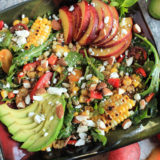Local Greens, and Some Easy, Tasty Ways to Enjoy Them
Local Greens, and Some Easy, Tasty Ways to Enjoy Them
Gorgeously green with broad, beautiful leaves, this season’s cooking greens continue to arrive fresh and delicious at the market, so what better time to take advantage of some of the healthiest leaves around? Offering an abundance of vital vitamins and nutrients, cooking greens are some of the most healthful and delicious vegetables available. While often dismissed as bitter or pungent, we’ll share preparations that have lovely flavor with a little bite.
Red, Green and Rainbow Chard from Our Friend, Phil Foster — a simple preparation.
We cooked some of this up this weekend and all I can say is Wow…the best chard I’ve had all year.
Here’s a terrific way to prepare it. Rinse well, then chop into bite-sized pieces. Then toss it in a pan with olive oil and a clove or two of sliced garlic. Stir until chard begins to wilt, then cover and let sit for 5 minutes. Season it to taste — a little sea salt may be all you’d want.
Carmelo’s cooking tip: after you’ve chopped the chard, separate the leafy pieces from those with the middle rib. The stem pieces take longer to cook, so put them in first and cook for 2-4 minutes. Then add the leafy pieces and cook as directed above.
Collard Greens & Kale
Collard greens are recognizable by their dark, blue-green, smooth leaves and a mildly bitter, cabbage-like flavor (in fact they are a non-head forming member of the same family). As one of the most notable greens in Southern African American cuisine, collard greens are traditionally slow-cooked for several hours, which allows their leaves to become increasingly tender. Collard greens are also particularly rich in anti-cancer phytonutrients and calcium.
Kale has a mild cabbage flavor and also resembles collards, yet kale leaves have beautifully curled edges and the strongest flavor and coarsest texture of all the greens. The most common variety is deep green, yet there are also colored kale varieties, referred to as savoy, which is most often grown for ornamental purposes though it is in fact edible. Kale stems tend to be a bit tough and are typically removed prior to cooking. However, if the stems are thin and tender, you can simply trim off the tips and cook them with the leaves.
These greens can be cooked separately or mixed together. Yet always be sure to clean them properly and remove all the natural grit that may be lurking on the leafy surfaces. Also, the quicker you can use your greens after purchasing, the less bitter they will taste.
Simply blanching and sautéing is an easy way to go. Add greens to a pot of boiling water until they begin to wilt, then drain in a colander and rinse with cold water. Press out as much of the water as possible, then cut the leaves into smaller pieces. Sauté with a little olive oil and garlic, or olive oil and chili pepper (a personal favorite), and you’ll have a wonderfully nutritious and delicious dish!
Broccoli Rabe
When it comes to Broccoli rabe, also known as Rapini, get ready for a pungent taste. For a quick veggie I just sauté with olive oil and garlic…stems first. Broccoli rabe cooks quickly so be careful not to overcook. For those who have not developed a taste for bitter greens, blanching first takes some of the bitterness out. Also partnering with less potent ingredients, such as pasta or polenta could make these greens a favorite.
Gai Lon
Gai Lon is also known as Chinese broccoli or Chinese kale. When shopping for these delicious greens look for dark green leaves, fresh stalks and flowers that are mostly in the bud stage, rather than blooming. Avoid bunches that look wilted or have yellow and brown blemishes. I find blanching and then stir-frying works best. I like adding just a bit of olive oil, garlic and soy sauce in the stir-fry. Remember to cook the stems first, and then add the more delicate leaves. Always be careful not to overcook.
Come Try These Greens!
Then, send your favorite way to enjoy them to share@sigonas.com and we might share it with others in our article.
Cheers,
Robbie Sigona










